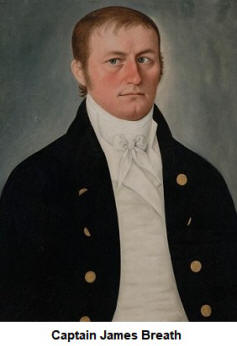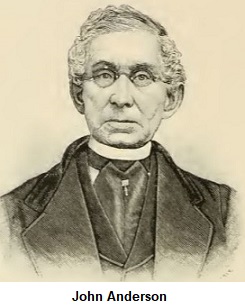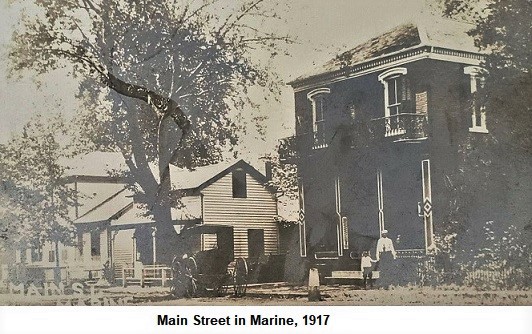Early History of Marine
Marine Settlement
Permanent settlement on the prairie in the southeast portion of
Madison County in Marine Township was made in 1813 and 1814 by Major
Isaac H. Ferguson, his brother-in-law John Warwick, John Woods,
George Newcome, Joseph Ferguson, Absolom Ferguson, Aquilla Dolahide,
Abraham Howard and Joshua Dean. In 1815, the settlement was
increased by the arrival of Chester Pain, Thomas Breeze, Richard
Winsor, John Campbell and John Giger, and in the following year came
Henry Scott, John Lord, James Simmons, Henry Peck, Andrew Matthews
Sr and Andrew Matthews Jr., Lefford, French, James French, and Abram
Carlock.

Captain Curtis Blakeman was one of the leading men of this colony.
He came with considerable wealth, while the others had been mostly
driven to Illinois either by poverty or a desire to obtain wealth.
Blakeman was a candidate for county commissioner in 1820, and was
elected to represent the county in the legislature in 1822. For a
number of years, he filled the office of Justice of the Peace. His
son, Curtis Blakeman Jr., was a prominent citizen of Madison County,
and was elected a representative in the legislature in 1842.
Rowland P. Allen was one of the first to build on the prairie and
was laughed at for his willingness to haul building material,
fencing, and firewood so far – a distance of half a mile. But in a
few years the older pioneers realized the advantages of a residence
on the prairie, and began to leave the gloom of the woods and build
in the sunshine.
A post office was soon established, with Major Ferguson and Rowland
P. Allen alternating as postmasters. The first tavern was kept by
Eben Twiss in section 11, in 1820, and the first ox-tread mill was
built by Captain Blakeman in 1823.
In 1820, John Anderson settled in Marine. He was born in Hoboken,
New Jersey in 1793. During the War of 1812, he offered his services
and was accepted as drummer boy. In 1822, he married Susan S.
Creamer, and together they had twelve children. After the death of
his first wife, he remarried April 23, 1868, to Margarett L.
Creamer, by whom he had two children. Anderson was successful and
amassed considerable property. He owned houses, barns, orchards,
etc. He died April 11, 1875. He was a man of unquestioned integrity
and had good business sense.
The Contemplated Town of Madison
The building of a town in Marine Township was contemplated by the
early pioneers. The town was to be named “Madison,” and 100 town
lots were offered for sale in the Marine Settlement, Illinois. The
auction was to be held November 18, 1820, at the home of Rowland P.
Allen. The lots were situated on the prairie, with thirty improved
farms located to the east, south, and west. Curtis Blakeman, Rowland
P. Allen, George C. Allen, Pierre Teller, Adrian Hegeman, Abraham
Beck, Nehemiah Allen, W. M. O’Hara, Justus Post, and Theophilus W.
Smith were the proprietors of the land. This sale of land did not
succeed, and the “paper” town of Madison in Marine Settlement was
never fulfilled.
The Founding of Marine
In 1834, the town of Marine was laid out by George W. Welsh, James
Semple, Jordan W. Jeffress, and Abram Breath. The first stores were
kept by Jordan W. Jeffress, George W. Welsh, and Abram Breath. The
first physicians were Drs. George T. Allen and P. P. Green.
The village of Marine was incorporated March 8, 1867 and
re-incorporated under general law on April 23, 1888. It was an
important station of the Illinois Central Railroad.
Early Businesses of Marine
The Cable Mill was built in 1866 by Curtis Blakeman Jr., John B.
Parker and Jacob Spies. It had but three run of stone, but after
Charles Valier and Jacob Spies took over the mill in 1876, the mill
was enlarged into a four-story brick building with numerous frame
additions and a cooper shop.
Other businesses by 1882 included physicians Peter S. Weidman, Peter
Fischer and Henry L. Judd; the Valentine Mill owned by John G.
Goerke; Henry Hoppe & Company; Henry Gehrs, and the Blanke Brothers,
who owned general stores. Fred Wentz and Kold & Richardson opened
hardware stores, and L. A. Richardson and Porter G. Parker owned
drugstores. A hotel was operated by H. H. Elbring. John M. Hettel
ran a stove and tinware, and Charles Adler, John Koch, V. Deibert,
and Michael Ford operated blacksmith and wagon shops. Henry A. Hoyer
was a wagon maker and bridge contractor, and Fred Webold was
carpenter and bridge builder. Julius Busch was a wagon maker and
millwright, and George Gravins and Henry Ortmann were furniture
dealers. Barbers included William Apffel and John Weber, and John
Deibert & Son owned a clothing and furnishing goods store. Harness
and saddlers included Henry Brandes and William Koeh. Charles Lewis
Varwig and Edward Frey owned cigar stores. Charles Pfister ran a
bakery and confectionery, and Catherine Nemnich, Mrs. Mary Ellison,
and Mrs. William Koch owned millineries. A meat market was owned by
Henry Schmidt and Jacob Weder, and the local watch maker was Andrew
Volk. Shoe makers included Herman Vanderstein, Peter Harnist, and
Henry Ackermann.
Early Schools of Marine
The first school in Marine Township was taught by Arthur Travis in
1814 in Major Ferguson’s smokehouse. Another of the early schools in
the Marine Settlement was a building made of logs, consisting of two
departments separated by a log partition. The first department was a
stable, accommodating several horses, and the second was a crib or
granary, utilized for scholastic purposes. The only entrance to the
schoolroom was through the stable, and teacher and pupils were
compelled to climb six feet of the log partition to enter. “The
conductor of this school,” wrote one of the pupils of those days,
“was a little effete, old codger, the most ignorant and illiterate
creature I ever knew as a teacher of the youthful mind. We were
instructed to always call the letter ‘Z,’ ‘Izzard,’ and in spelling
Aaron, to say, ‘Big A, little A, r-o-n, Aaron.’ The next teacher who
attempted to teach at Marine was Mr. Giles Churchill, the most
bashful and awkward of men. He had studied English grammar in
Webster’s spelling book, and said he could teach it if anybody
wanted to learn. Nearby in the woods was a whisky distillery, and
the teacher would sometimes rest at this point and imbibe too freely
of corn-juice for the successful advancement of education. One way
or another, he did manage to teach the young minds.
In 1819 a young man from New Haven, Connecticut opened a school in
an empty cabin that stood between Captain Blakeman’s and R. P.
Allen’s. In 1821, a substantial Union Church house was erected,
which was likewise used for school purposes. It is believed to have
been at the time the best building devoted to educational purposes
in the county, as it was a frame building with clapboard siding,
supplied with split shingle roof and glass windows. In 1874 a
two-story, five room brick schoolhouse was erected, with five
teachers. The cost of the building was $10,000.
Early Churches in Marine
The first sermon in Marine Township was preached at Major Ferguson’s
home in 1813 by Rev. Samuel Lindley, a Baptist missionary. A Union
Church building was erected in section 33, in 1821. Another church
was organized November 02, 1834, with Roswell Brooks as preacher,
succeeded by Robert Blake. After about three years the church became
vacant, until 1840, when Thomas Lippincott became preacher. After a
revival, twenty-seven were added to membership. Original members
included James Breath, Elizabeth Breath, George C. Allen, Mary
Allen, James M. Nichols, Elizabeth Nichols, George W. Walsh, John R.
Kerr, William Anderson, Eunice A. Anderson, Gertrude Anderson,
Zilphatt Parker, George Foster, Hannah N. Foster, Rebecca L. Breath,
and Mary A. Breath. In 1851 a frame church was constructed.
On April 7, 1860, the Marine Church of Christ was established at a
place then known as the Reid schoolhouse. Elder William Birge acted
as minister. Original members included A. W. Jeffress, Mary A.
Jeffress, J. W. Jeffress, D. W. Biggs, Catherine Biggs, Elisha
Stapleton, Mary Stapleton, Curinda Stapleton, Anna R. Farghuharson,
Mary E. Parker, Margaret Graham, Adaline O. Bacon, Ella Stocton,
Harriet Weidman, and Ella Bocsinger. In 1871, a church was
constructed at a cost of $2,500.
By 1882, there were five churches in town – the Roman Catholic,
German Lutheran, and Christian (all with brick buildings), and the
Presbyterian and Methodist (with frame structures).

